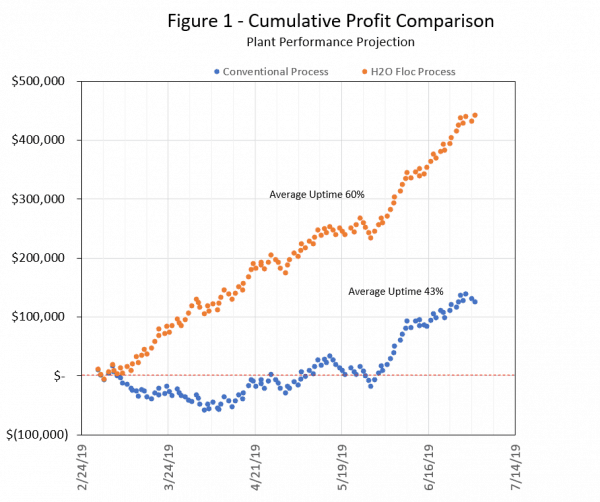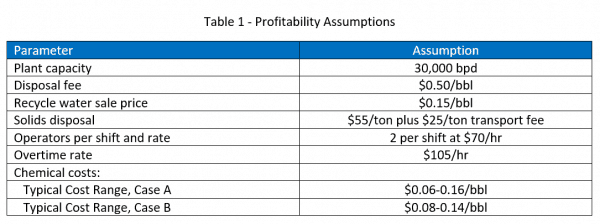As the shale industry moves forward at a rapid pace, several factors have the potential to create a bottleneck to production growth. These factors include pipeline capacity, refining capacity, regulations, etc., but one of the most important factors that can impede growth is overall produced and flowback water management. While there are many shale areas in the US, including Marcellus, Eagle Ford, Bakken, Permian, and several others, this blog is focused on produced water challenges in the Permian Basin. Current oil production in the general Permian Basin is over 4MBPD with projections of continued growth to 8MBPD by 2025. Current water to oil ratio in the Permian is 4:1 so the respective produced water volume is approximately 16MBPD. This is expected to increase to over 25MBPD by 2023.
As the water production increases, the perception of produced water management is changing rapidly in the industry. No longer just a waste stream, produced water recycling is gaining more momentum and operators are moving toward higher percentages of produced and flowback water recycling in their water management plans.
With the current price of oil expected to remain in the $50-$60 range and investment groups looking for efficient capital allocation, operators will need to implement cost-effective recycling systems to enhance their produced water management programs.
This blog is focused on these key areas to improve reliability, reduce costly downtime, handle upsets and how to develop a robust, cost-effective produced and flowback water recycling program.
- Understanding Water Chemistry and Hydraulic Fracturing Requirements
- Water Treatment Equipment Selection and Optimization
- Training of Operators (reducing labor costs associated with process upsets)
- Life Cycle Costs vs. Short Term CAPEX
Understanding Water Chemistry and Frac Requirements
Most operators and service companies understand the hydraulic fracturing chemistry requirements quite well but may not understand the challenges of recycling produced and flowback water. The fastest and easiest way to eliminate produced and flowback water treatment issues is to use freshwater as a standalone source or as a blend for hydraulic fracturing operations. However, the use of freshwater is limited in many areas and potential regulations can significantly impact utilization of freshwater resources. The composition of this produced and flowback water has a significant impact on the efficiency of the hydraulic fracturing operation.
Many treatment systems target specific contaminants such as turbidity (TSS), iron, bacteria, H2S, and free oil. Depending on operator specifications, treatment schemes can vary widely at different facilities, from simple aeration and oxidant injection to more sophisticated treatment programs that include oxidant, coagulant, flocculant, and biocide.
Understanding water composition and the effects that components will have on chemistry is essential to developing a cost-effective chemical treatment program. Therefore, the first step is to perform a reliable water analysis to determine the best approach. If evaluating a water analysis is not your expertise, then consult an expert to review and provide recommendations.
Water Treatment Equipment Selection and Optimization
Many water treatment systems struggle to consistently achieve treatment goals. This is often due to equipment selection and operation. Operators must decide how to remove contaminants from the system, and this is achieved by a variety of methods such as gravity settling, flotation, or filtration. While CAPEX might cost more in the short term, downtime and life cycle costs of poor equipment design and operation can end up costing so much more in the long run. It is our experience that equipment selection and optimization is one of the main areas that is overlooked by operators as they tend to focus more on the chemistry. Therefore, we see this as a significant opportunity for optimization as produced water treatment systems become larger due to increased production volumes.
Training of Operators
One of the more costly areas of produced and flowback water recycling is the labor costs associated with the operation of a facility. Lack of training or experience can cause operators to over utilize chemical injection for troubleshooting during process upsets. This results in increased OPEX and can severely affect overall profitability for the recycling facility. In addition, when upsets are not responded to properly, system shut downs are typically the result. This affects profitability as well as contractual obligations when recycled water volumes are guaranteed to a customer. Training should be accounted for when setting up your water management plan.
Life Cycle Costs vs. Short Term CAPEX
In the current oil price environment, companies operating a produced water recycling facility need to be cost conscious. This includes operators handling their own facilities, midstream water companies providing recycled produced water to operators, as well as service providers that are responsible for treatment and recycle schemes. However, as highlighted above, short term thinking can have a significant impact on overall life cycle costs. It’s important to understand full life cycle costs associated with your produced and flowback water treatment plan.
As an example, the following is an excerpt from an analysis of the cost to profitability of a recycling system due to system shut down.
To help assess process economics and better understand the importance of process robustness in current reuse operations, Water Standard, through its produced water subsidiary, Monarch Separators, performed an analysis of existing plant operations in the context of recent full-scale test results.
In evaluating current recycling facility operations, it became apparent that upset-related downtime is a common occurrence, and the ability to achieve greater uptime was identified as the key criteria for economic success at most recycling facilities.
An overview of this analysis is presented in Figure 1 below. The data represents approximately four months of operation at a 30,000 BPD facility. The current chemical treatment scheme (Case A) fails to perform when daily average water quality fluctuations are greater than 125% of the previous 24 hour period, while Case B represents a more robust chemical treatment that maintains treatment performance through inlet water quality fluctuations up to 300%. Water quality upsets (turbidity, oil and iron) modeled in Figure 1 represent that of a typical facility and are shown graphically in Figure 2. Key assumptions for the analysis are provided in Table 1. This analysis is based on water fees collected on throughput: disposal fee $0.50/bbl and recycle sale $0.15/bbl.
In comparing uptime between Case A and Case B, the uptime at this facility shifts from 43% to 60% with an increase in cumulative profits from $126,000 to $443,000, demonstrating the value of applying a chemical treatment regime that can meet treatment goals through a wider range of upset conditions experienced by the recycling facility.

Conclusion
In summary, challenges associated with produced and flowback water management will continue to grow as US unconventional oil production expands. Operators, midstream and service companies will need to work together to develop a cost effective, sustainable solution to this challenge. In the current market, profitability can be achieved when these companies optimize their water program within the four key areas presented herein:
- Understanding Water Chemistry and Hydraulic Fracturing Requirements
- Water Treatment Equipment Selection and Optimization
- Training of Operators (reducing labor costs associated with process upsets)
- Life Cycle Costs vs. Short Term CAPEX
It is Water Standard and Monarch Separators’ mission to collaborate with our customers to help make them even better at what they do best. This includes oil and gas production for shale operators, water treatment and transfer for midstream companies, and water treatment support for service providers.
We hope that you find the content of this blog helpful and we welcome feedback that may be of use to others.
Our team of experts is ready to take your water treatment efficiency to the next level so contact us today to speak to a Produced Water Specialist or visit our Water Treatment Services page to schedule one of our many services designed to optimize your operations.
-Duane
About Duane Devall
With 24 years of global experience in the oil and gas industry, Duane has spent 13 of those years in upstream produced water treatment. He currently serves as Vice President of Global Sales at Water Standard and Monarch Separators, where he enjoys developing customer relationships and providing optimized solutions for their water treatment needs. The company appreciates his dedication to clients along with his uncanny ability to bring laughter and humor to any situation. Fun fact about Duane: He is a sports fanatic who loves Houston teams and enjoys watching the games with four small, furry Shih Tzu dogs by his side.


